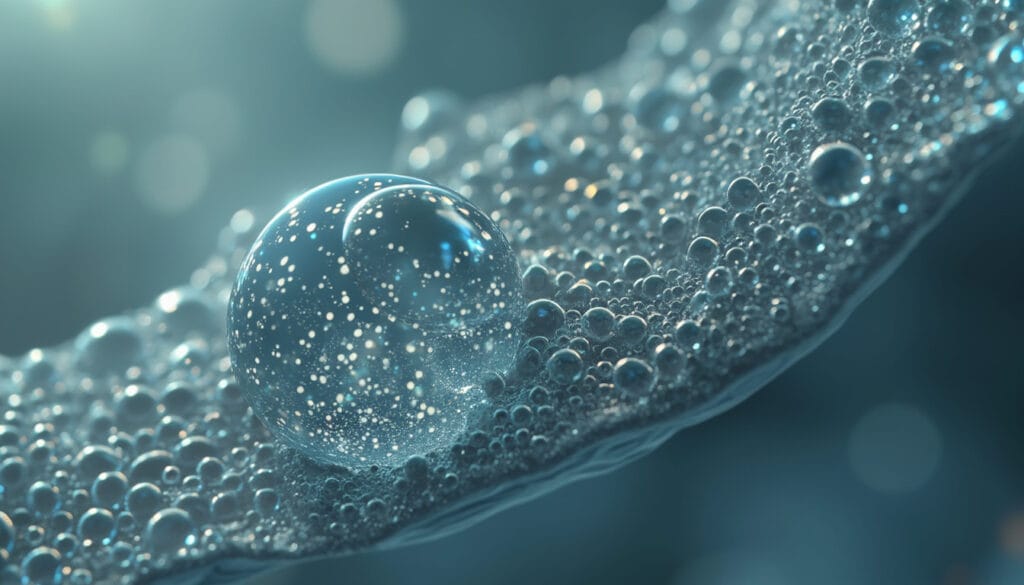Microplastics are invading our environment even in the most unsuspected places.
Recently, researchers have discovered their presence in the follicular fluid of human ovaries.
This finding raises serious questions about the potential impacts on female fertility.
The discovery of microplastics in the follicular fluid, essential for egg development, could disrupt the hormonal balance and overall reproductive health. This contamination threatens not only fertility but also women’s ability to maintain optimal hormonal balance. The implications of this study are alarming and highlight the need for urgent action to limit exposure to these toxic substances. Microplastics carry numerous hazardous chemicals known for their harmful effects on the human body.

What is follicular fluid and its importance?
The follicular fluid is an essential biological fluid that surrounds oocytes in female ovaries. It plays a crucial role in providing the nutrients and biochemical signals necessary for egg development. This specialized environment promotes the maturation of oocytes and their preparation for fertilization. The quality of follicular fluid is therefore directly related to the fertility and reproductive health of women. A disruption of this environment can lead to hormonal dysfunctions and a decrease in oocyte quality, thus impacting the capacity for conception.
How were microplastics detected in the follicular fluid?
For the first time, microplastics have been identified in human follicular fluid thanks to a study published in Ecotoxicology and Environmental Safety. Researchers analyzed the follicular fluid from 18 women undergoing assisted reproduction treatment at a fertility clinic in Salerno, Italy. Microplastics were detected in 14 of these women, revealing the ubiquitous presence of these particles in the human body. This discovery was made using advanced microscopy and spectrometry techniques, allowing the detection of plastic fragments of various sizes in complex biological samples.
What are the implications of microplastics for female fertility?
The presence of microplastics in follicular fluid raises numerous questions about their potential impact on female fertility. Microplastics can contain up to 16,000 plastic chemicals, some of which are highly toxic, such as Pfas, bisphenol, and phthalates. These compounds are known for their deleterious effects on the endocrine system, possibly leading to hormonal disruptions, ovarian dysfunctions, and altered maturation of oocytes. By contaminating the follicular fluid, microplastics can disrupt the biochemical signals essential for egg development, thus affecting oocyte quality and reducing chances of conception.
What are the effects of microplastics on women’s reproductive health?
Microplastics have been associated with various reproductive health problems in women. Animal studies have shown that exposure to microplastics can lead to dysfunctional ovarian function, reduced oocyte maturation, and decreased fertilization capacity. Moreover, microplastics can cross biological barriers, reaching the brain and placenta, which poses additional risks to reproductive health. According to Luigi Montano, the principal investigator of the study, this discovery should serve as a wake-up call regarding the invasion of emerging contaminants in the female reproductive system.
Where do microplastics come from and how are we exposed to them?
Microplastics are found everywhere in the environment, from the peaks of Mount Everest to the depths of the Mariana Trench. One of the main routes of exposure to microplastics is through food, with traces of these particles found in various meat and plant products. Growing plastic pollution leads to ubiquitous contamination, where microplastics are ingested through food, water, and even air. Single-use plastics significantly contribute to this crisis by breaking down into microscopic particles that enter food chains.
What measures can be taken to reduce exposure to microplastics?
Reducing exposure to microplastics requires several concrete actions in daily life. On one hand, decreasing the use of plastics, especially in the kitchen, can significantly reduce risks. This includes adopting alternative solutions such as wooden or stainless steel utensils and avoiding heating food in plastic containers. Additionally, choosing food products from organic agriculture can limit the ingestion of microplastics present in pesticides. It is also recommended to avoid disposable paper cups and tea bags that may release plastic particles when in contact with hot liquids. Adopting more conscious consumption and reducing plastic waste production are essential steps to decrease overall exposure to microplastics.
What are the next steps for research on microplastics and reproductive health?
The discovery of microplastics in human follicular fluid represents a major advance, but many questions remain unanswered. Researchers, including Luigi Montano and his team, continue to explore the extent of microplastic contamination in the human body, particularly in urine and sperm. Larger epidemiological studies are needed to determine critical levels of exposure from which negative effects begin to manifest. Furthermore, it is crucial to precisely quantify the impact of microplastics on reproductive health and to develop effective strategies to reduce their presence in the environment. Future research will also aim to evaluate the effectiveness of measures to reduce plastic use and the adoption of organic dietary regimens in decreasing microplastic levels in the body.
What are the dangers of the chemicals contained in microplastics?
Microplastics are not only harmful physical particles; they also carry numerous toxic chemicals. Among these substances, Pfas, bisphenol, and phthalates are particularly concerning due to their potential to induce hormonal disruptions, neurotoxicity, and even cancers. These chemical compounds act as a Trojan horse, facilitating the entry of microplastics into sensitive areas of the body, such as the ovaries. Once inside, these chemicals can alter hormonal processes and harm women’s reproductive health. Research shows that these contaminants are already well established to disrupt the endocrine system and cause significant damage to female reproduction.
How do microplastics influence oocyte quality?
Microplastics present in follicular fluid have a direct impact on oocyte quality. By disrupting the nutritional and biochemical environment essential for egg development, these particles can lead to decreased maturation of oocytes and a reduction in their fertilization capacity. Oocytes contaminated with microplastics are more likely to have genetic anomalies and hormonal dysfunctions, compromising their viability. Furthermore, the toxic chemicals associated with microplastics may alter the cellular metabolism of oocytes, thereby reducing their ability to develop fully and support a healthy pregnancy.
What are the societal impacts of microplastic contamination?
Contamination by microplastics has repercussions that extend beyond the individual level, affecting society as a whole. The decline in fertility rates and the increase in reproductive health problems can pose significant demographic and economic challenges. Couples facing conception difficulties may be confronted with high costs associated with fertility treatments, while public health systems will have to manage an increase in cases of hormonal dysfunctions and diseases related to plastic contaminants. Additionally, the growing awareness of the dangers of microplastics could lead to changes in consumption habits and increased pressure on industries to reduce plastic use and develop safer alternatives.
How to raise public awareness of the dangers of microplastics?
Public awareness is essential to combat contamination by microplastics. It is crucial to inform consumers about sources of exposure and available preventive measures. Education campaigns can encourage individuals to adopt more environmentally friendly behaviors, such as reducing the use of disposable plastics and choosing organic food products. Moreover, educational institutions and the media have a key role to play in disseminating accessible scientific information and encouraging citizens to support policies aimed at limiting the production and dispersion of microplastics. Additionally, promoting continuous and transparent research can enhance collective understanding of the impacts of microplastics and spur concrete actions to protect reproductive health and the environment.
What are the alternatives to plastics to reduce pollution?
To reduce pollution from microplastics, it is essential to find and adopt sustainable alternatives to plastics. Natural and biodegradable materials, such as wood, bamboo, glass, and stainless steel, offer viable options to replace plastics in many everyday applications. For example, using stainless steel utensils instead of plastic can decrease the release of microplastics during cooking. Similarly, opting for reusable glass or stainless steel containers for food storage reduces reliance on plastic packaging. Furthermore, encouraging recycling and reuse of materials can help limit the accumulation of plastic waste in the environment. The development of biodegradable plastics and innovative technologies for managing plastic waste also represents a promising avenue to tackle microplastic pollution.
What role do regulations play in managing microplastics?
Regulations play a crucial role in managing and reducing contamination by microplastics. Governments and international organizations need to implement strict laws and policies to limit the production and use of single-use plastics. Bans on certain types of plastics, restrictions on hazardous chemical additives, and higher standards for recycling can help reduce the impact of microplastics on the environment and human health. Furthermore, promoting research and the development of alternative materials and supporting initiatives aimed at cleaning up plastic waste present in ecosystems are vital measures. International collaboration is also necessary to address this issue on a global scale, ensuring a coordinated and effective response to the threat posed by microplastics.
How can industries contribute to the reduction of microplastics?
Industries hold a primary responsibility in reducing pollution from microplastics. They can adopt more sustainable manufacturing practices by reducing the use of plastics, replacing traditional plastics with eco-friendly alternatives, and improving recycling processes. Additionally, industries can invest in research and the development of innovative technologies to produce biodegradable plastics and minimize generated plastic waste. Moreover, establishing corporate social and environmental responsibility programs allows companies to actively engage in protecting the environment and public health. Collaborating with governments and non-governmental organizations to develop joint strategies can also enhance efforts to reduce microplastics and promote long-term sustainable solutions.
What are the benefits of reducing plastics on reproductive health?
Reducing the use of plastics presents significant advantages for women’s reproductive health. By decreasing exposure to microplastics and the toxic chemicals they contain, it is possible to reduce the risks of hormonal dysfunctions, ovarian disturbances, and decreased oocyte quality. Such a reduction can also help improve fertility, reduce premature birth rates, and prevent other reproductive health issues related to plastic contamination. Moreover, by protecting the environment from plastic pollution, a healthier ecosystem is fostered, which positively impacts the overall health of populations. Adopting plastic reduction practices is therefore beneficial not only for individual health but also for collective well-being and the preservation of biodiversity.
What challenges need to be addressed to eliminate microplastics from the environment?
Eliminating microplastics from the environment represents a complex challenge requiring multidimensional efforts. One of the main obstacles is the ubiquitous nature of microplastics, which are found in nearly all ecosystems, from freshwater to oceans, and even in the air we breathe. The ongoing fragmentation of plastics into smaller and smaller particles makes their removal difficult with current technologies. Additionally, the sources of pollution are varied, ranging from poorly managed plastic waste to microfibers released by textiles. Implementing more effective waste management systems, improving recycling infrastructures, and developing innovative methods to capture microplastics are essential. Moreover, raising public awareness and encouraging more responsible behaviors regarding consumption and waste management are key elements to reduce the production of microplastics at the source.
#>
Articles similaires
Thank you!
We will contact you soon.














